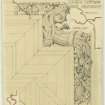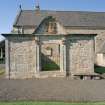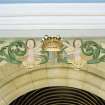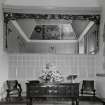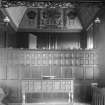Pricing Change
New pricing for orders of material from this site will come into place shortly. Charges for supply of digital images, digitisation on demand, prints and licensing will be altered.
Abercorn Church And Anglian Monastery
Church (11th Century), Monastery (Period Unassigned), War Memorial(S) (20th Century)
Site Name Abercorn Church And Anglian Monastery
Classification Church (11th Century), Monastery (Period Unassigned), War Memorial(S) (20th Century)
Alternative Name(s) Aebbercurnig; Abercorn Monastery; Abercorn Kirk; Abercorn Parish Church; War Memorial Plaque And Window
Canmore ID 49123
Site Number NT07NE 1
NGR NT 08141 79097
Datum OSGB36 - NGR
Permalink http://canmore.org.uk/site/49123
First 100 images shown. See the Collections panel (below) for a link to all digital images.
- Council West Lothian
- Parish Abercorn (West Lothian)
- Former Region Lothian
- Former District West Lothian
- Former County West Lothian
Abercorn Kirk, from 11th century
As Norman parish kirks go in Scotland, Abercorn must have been a fairly substantial example - wide nave and choir, the latter tenanted by the splendid Hopetoun Loft. Most of what you see is by Peter MacGregor Chalmers, 1893. Two stained-glass windows by Douglas Strachan, 1921. Fine 12th-century south door, chevron stonework in tympanum, and west door, 1893, in ferociously crisp Norman with grimacing gargoyles. Aisles sprout from the torso so much as to conceal it: the Binns aisle, 1618; the Philpstoun burial enclosure, 1723; the Duddingston aisle, 1603; and the Hopetoun aisle, 1707. The Hopetoun Loft occupies the chancel and faces down the kirk displaying the magnificence of its panelling and fretwork screen by Alexander Eizatt, and the armorial achievement painted by Richard Waitt. The adjacent aisle is a two-storey, harled piece of swagger by Sir William Bruce, complete with pyramid roof, ashlar-panelled windows, and a wonderfully panelled retiring room above burial enclosure below. Atmospheric arboreal kirkyard. Outstanding collection of early carved stones in gatehouse.
Taken from "West Lothian: An Illustrated Architectural Guide", by Stuart Eydmann, Richard Jaques and Charles McKean, 2008. Published by the Rutland Press http://www.rias.org.uk
Abercorn 1, West Lothian, cross-shaft fragment
Measurements: H 1.40m, W face A 0.46m to 0.37m; face C 0.41m to 0.36m; D face B 0.23m to 0.22m; face D 0.26m to 0.22m
Stone type: sandstone
Place of discovery: NT 0814 7907
Present location: in the museum at Abercorn Church (Canmore 251979).
Evidence for discovery: found re-used as a window lintel inside the church during repairs.
Present condition: set in cement on modern plinth, worn but carving still detailed. Left margin of face C has been chiselled off.
Description
This is the upper part of a cross-shaft carved in deep relief on all four faces, with a roll moulding at the edges and an inner roll moulding on each face. At the top is the start of the missing cross-head. Face A is divided into two complete and two incomplete panels of ornament by roll mouldings. The lowest panel contains an incomplete double spiral ring-knot, above which is a panel of two-strand interlace, the pattern turned with a central break. Above again is a panel of diagonal key pattern, and at the top is the basal part of a panel, the carving of which is too damaged to make out, but which appears to be figural rather than interlace.
Face B has a single panel of complex interlaced medallion scroll with single-ridged nodes, in which each medallion contains a slightly different design of twisted sprays of trilobed berry bunches and veined pointed leaves. There are also leaves, single berries and pointed berry bunches in the spaces between the medallions. There is a wider panel of interlaced medallion scroll on face C, although the sinister margin has been damaged by later trimming. Here the medallions contain fleshy pointed leaves, single berries and trilobed berry bunches, and there are leaves and berries in the spaces outside the medallions. At the top there is the base of a panel of interlace pattern. On face D there is a single panel of scroll foliage with triple-ridged nodes, trilobed berry bunches and veined triangular leaves, two of which pass under the stem of the vine. Between each scroll is an elongated veined leaf or frond. At the top is the basal part of a panel of diagonal key pattern, which marks the base of the lower arm of the missing cross-head.
Date: eighth century.
References: ECMS pt 3, 418-19; RCAHMS 1929, no 274, cross no 1.
Desk-based information compiled by A Ritchie 2016
NT07NE 1.00 08141 79097
(NT 0814 7910) Church on supposed site of Abercorn Monastery (NR)
OS 6" map (1922).
NT07NE 1.01 Centred NT 08147 79077 Burial-ground (including cross and hogback stone)
NT07NE 1.02 NT 08114 79046 Museum (including cross-shafts)
Location formerly entered as NT 0814 7911.
Trial work at this monastic site, the 'Aebbercurnig' of Bede, now a parish church and kirkyard, began in 1963, and was extended further by A C Thomas, for Edinburgh University Archaeology Dept. Six areas were opened, one within the kirkyard, revealing two phases of occupation.
The earlier corresponds to the Anglian monastery, established some time before 685, perhaps temporarily abandoned at that date following the Northumbrian defeat at Nechtansmere, but apparently re-occupied in time to produce the series of 8th century Anglian crosses now housed in the vestry.
The monastery consisted of a large roughly oval enclosure sited on a spur between the confluence of two streams. With difficulty, this vallum can still be traced. In the N part of the interior, N of the present church, the Romanesque nave of which may occupy the site of the Anglian chapel, cuttings have revealed traces of two small, apparently rectangular structures, possibly cells. One is constructed of thick, dry-stone walls, the other is defined by a long sleeper-beam trench, and perhaps median post-holes. Sherds of class E imported ware in primary contexts confirm the dating of this phase.
The later period of use, separated from the earlier by several feet of collapse and a laid pavement, yielded 13th century pottery, animal bones, slag and some minor artifacts. These may refer to no more than a former vicarage (existing here in 1274) or possibly a lodging for the bishop of Dunkeld in the previous century, when Abercorn was in that diocese.
Excavations were continued after 1965, and in 1967 Thomas states that what may be the N and (apsidal) E sides of a small wooden church and internally (less apse) of the order of 20' x 27' had been found, defined by sleeper-beam trenches - presumably those mentioned earlier. Three hog-backed stones are also in the vestry.
The present church dedicated to St Serf (H Scott 1915) dates from the later 11th century and has been much altered; originally it consisted of an aisleless nave and chancel.
J R Allen and J Anderson 1903; RCAHMS 1929, visited 1926; SDD List 1964; D M Wilson and D G Hurst 1965.
Abercorn Church is in normal use. There is no real evidence of the monastery but at NT 0814 7912, in the bottom of several excavation trenches, are the footings of stone walls. These may be the remains of the vicarage or lodging house referred to by Thomas. An unsurveyable ridge crosses the SE part of the present graveyard and may represent the vallum. The hog-backed stones and cross-slabs were not seen, the vestry being locked.
Visited by OS (JP), 27 March 1974.
Abercorn Parish Church: In origin a 12th century church of the standard two-cell type, but the only feature certainly of that date is the blocked S door squeezed in between later burial aisles. The church was reconstructed in 1579 and three appendages were added later to the S side for local families. The Philpstoun enclosure, dated 1727, and the Binns aisle of 1618 are built on to the nave. The Duddingston aisle of 1603 abuts the (former) chancel which was fitted out in 1708 as the Hopetoun Aisle; an annexe was built to the N at that time. In 1893, the church was restored; the old belfry was rebuilt and the W end Normanized; an aisle was added along the N side.
C McWilliam 1978.
Non-Guardianship Sites Plan Collection DC23010-DC23013,1964-1965.
NMRS REFERENCE:
Architect: Sir William Bruce 1708 (Hopetoun Aisle - carving by William Eizat, painting by Richard Waitt)
Sir William Bruce c.1700 (Laird's loft)
NMRS Miscellaneous:
Reprinted from Proc. Soc. Antiq. Soc. Vol LXXII by Charles S. T. Calder 'Three Fragments of a Sculptured Cross' - text and drawings (D5/WG(P))
Reprinted from Proc. Soc. Antiq. Soc. Vol LXXII by Thomas Ross 'Hog-backed Monuments' - text and drawings.
(Undated) information in NMRS.
Photographic Survey (July 1962)
Photographic survey by the Scottish National Buildings Record/Ministry of Works in July 1962.
Publication Account (1975)
Abercorn is an ancient place. Today's quiet, secluded hamlet belies its former importance but the name itself betrays an early 'British' or 'Cumbric' presence' the homed river-mouth', probably referring to the promontory on which the church is sited, close to where the Midhope Bum meets the Firth of Forth.
Most of the surviving church is 16th century and later, with the north aisle and the belfrey rebuilt in 1893. Kirk (no. 54) The Hopetoun loft, Abercom Kirk (no. 54) . The building was reconstructed in 1579 and subsequently three burial aisles were added to the south side-the Duddingston aisle (1603), the Binns aisle (1618) and the Philipstoun enclosure (1727). The stylish and splendid Hopetoun Loft at the east end was fitted out in 1708 using the same wood-caler and architect as engaged for Hopetoun House (no. 30). William Eizat carved the elegant foliage and coronets; Sir William Bruce also designed the two-storey Hopetoun aisle on the north side. This had its own semi-circular forecourt and private drive from the House, its own private entrance and a retiral room above, communicating with the Loft Below is the family burial vault, whilst in the churchyard there are a number of good 17th-18th century gravestones, some with trade symbols associated with estate crafts and trades such as the gardener.
But Abercorn is more than simply an interesting post Reformation church. Insignificant in the south wall, sandwiched between the later burial aisles and not to be confused with the neo-Norman west doorway and arcade within, is an original blocked-up 12th century Norman doorway. It is a simple, small doorway to what was a two-cell church. The arch is decorated with shallowly-calVed chevrons whilst the tympanum, just below, carries a diamond or lozenge patterning. This tympanum is one of only two decorated examples known to survive in Scotland-that at Linton (NT 773262) in Roxburghshire has a figural relief unique in Scotland (as well as a fine Norman tomb).
Nothing survives of the even earlier Anglian monastery. But Christianity at Abercorn long pre-dates the Anglo-Normans. Bede writes that its bishop and monks fled to Whitby in AD 685 after the Pictish victory at Nechtansmere-thus confirming a see based on the site by the late 7th century. What do survive, however, are sections of standing crosses of Anglian design, presently sited just off the vestry. The predominance of abstract patterns (as opposed to carvings of human figures, birds and beasts), puts them well into the 8th century. And continuity of a Christian presence is further evidenced by two virtually complete hogbacked tombstones (and fragments of a third) of 11 th-12th century date. Their escalloped and square scaling imitates the shape of roof shingles or tiles (see section 6).
The importance of Abercorn in early Christian Scotland should not be underestimated, nor its vulnerable position for so long in a frontier zone between British, Pictish, Anglian and Scottish areas of interest.
Information from 'Exploring Scotland's Heritage: Lothian and Borders', (1985).
Measured Survey
Drawings by A Walker Webster in the National Art Survey of Scotland Collection.
Measured Survey
Drawings by John S Hardie in the National Art Survey of Scotland Collection.
















































































![Photographic copy of three rubbings. The left rubbing is unidentified. The middle and right rubbings show detail from the left side [middle] and face [right] of Abercorn No. 2 cross slab.](http://i.rcahms.gov.uk/canmore/l/SC01415700.jpg)


























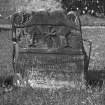





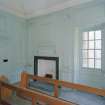










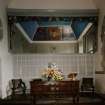












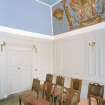
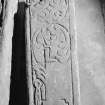
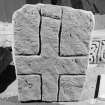






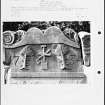

































![Photographic copy of three rubbings. The left rubbing is unidentified. The middle and right rubbings show detail from the left side [middle] and face [right] of Abercorn No. 2 cross slab.](http://i.rcahms.gov.uk/canmore/s/SC01415700.jpg)
